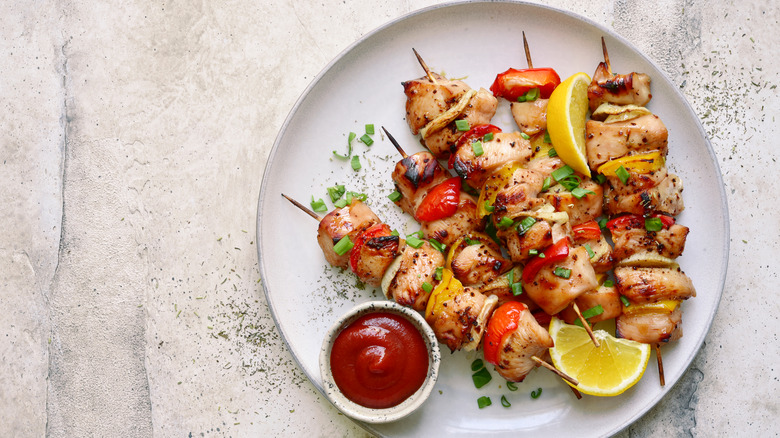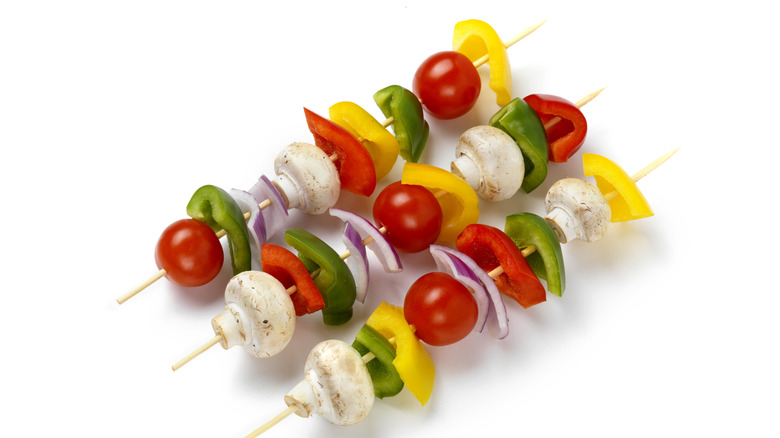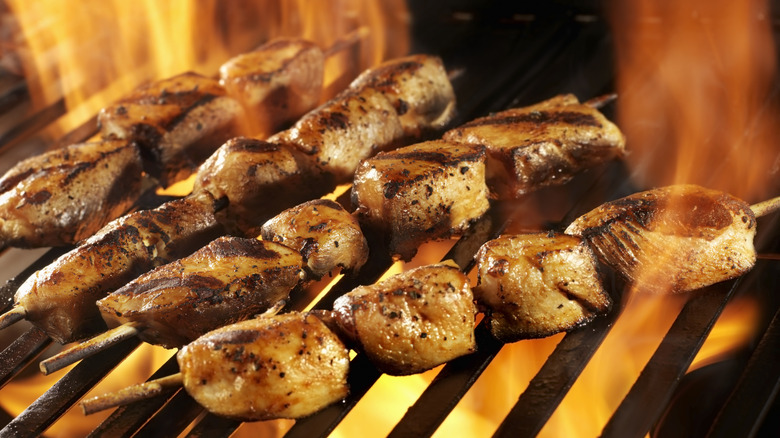When Freezing Kebabs, Separate The Meat From The Veggies
Time is precious, and batch cooking can be a lifesaver in the kitchen. However, reheating frozen chili con carne, bolognese, or lasagna can get pretty ground-hog-esque. If you want to spice up those freezer drawers, kebabs can be an exciting midweek dinner. They're also great for preparing for future barbecues and summer evenings by the grill. If you plan to freeze kebabs, it's helpful to know that freezing the meat and vegetables separately is the way to go.
While the visual appeal of a kebab skewer is the vibrant layers of vegetables and meat, it's best not to freeze in this order. Just like different meats require specific freezing methods (raw or cooked), vegetables also respond differently to the freezing, thawing, and cooking processes. With this in mind, when preparing kebabs ahead of time, consider separating the two elements of the kebab — with all-meat skewers and all-veggie skewers — to get the tastiest overall dish afterward.
Keep the meats and vegetable skewers separate
To effectively freeze kebabs, it's best to separate the meat and vegetables from one another. You can freeze kebabs before or after cooking them. However, vegetables and meat react differently to freezing. This is due to the way enzymes (present in both foods) react during the freezing process. Enzymes in meat, fish, vegetables, and fruit contribute to food spoiling, and freezing slows down this process. The difference between your kebab components is that frozen raw vegetables will start to lose their color, texture, and flavor, while partially cooking them before freezing will help to retain this. It's a great method to also keep mushrooms fresher for longer.
In this case, it's best to freeze the partially cooked vegetables separately, especially if you don't want to pre-cook the kebab meat before freezing. This also makes more sense when you consider that your vegetables and meat may require different cooking times, particularly if you're cooking from frozen and thawed. As well as this, before freezing, it's best to marinade and salt the kebabs first. If you decide to cook the kebabs before fully thawed, you want the meat thoroughly infused with flavor beforehand.
Best post-freeze cooking
Frozen vegetables can be cooked on the grill easily and efficiently without defrosting. Meat, on the other hand, can take up to 50% longer to cook frozen, and it is essential to raise the core temperature of the meat to a safe internal temperature (which the USDA says differs depending on the meat you decide to add to your kebabs).
Outdoor grills can also vary in heat, depending on temperature or weather conditions. So monitoring frozen meat on the grill is essential if you cook it frozen. With these combined factors, it is recommended to thaw frozen kebab meat before throwing it on the grill. It's not necessarily time-convenient, but food safety is paramount. Transfer the kebab meat from the freezer into the fridge, and the defrosting can occur overnight.
Once you've cooked the vegetable and meat elements of the kebab, you can thread these alternatively onto skewers and recreate the colorful kebab appearance. Using a vegetable as a backstop is the best way to prevent hand injuries from the skewers. If re-threading the kebabs is a hassle, you can always create a DIY board where individuals can customize their kebab skewers from cooked ingredients.
The next time you consider whether to freeze kebabs, be sure to keep the vegetables and meat on separate skewers. This will enhance their flavor and overall deliciousness when cooked. It's a win, win scenario.


